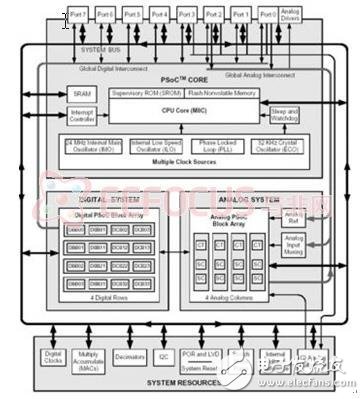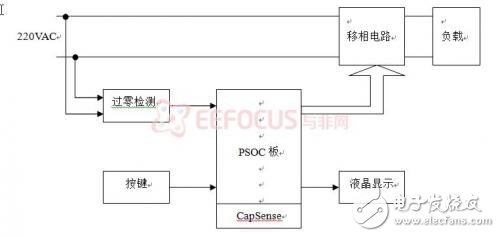Summary:
This article presents the design and implementation of a phase shift controller based on the PSOC 3 platform from Cypress. The system leverages CapSense technology for input signal acquisition, enabling digital phase modulation through the PSOC to achieve precise power control. It also provides customizable input signals to meet diverse user application needs.
Introduction:
In industrial settings, power adjustment is commonly achieved using thyristor-based phase control, which modulates the conduction angle of AC signals to regulate output power. However, traditional methods rely on potentiometers, which suffer from mechanical wear, noise, and limited precision. This design replaces mechanical controls with a digital solution by integrating PSOC technology, utilizing CapSense and buttons as input interfaces. This approach eliminates the drawbacks of analog adjustments and offers more reliable and flexible control.
PSoC Overview:
PSoC (Programmable System-on-Chip) is a highly integrated microcontroller developed by Cypress Semiconductor. It combines an 8-bit microprocessor, programmable analog and digital modules, and features like IDAC (current source), I2C, Flash, SRAM, and other peripherals. As shown in Figure 1, this architecture allows developers to implement complex analog and digital functions without external components. Cypress provides a wide range of pre-built user modules, such as operational amplifiers, ADC/DACs, timers, comparators, and touch-sensing blocks, which can be easily configured via software. This simplifies the design process and reduces development time significantly.
System Principle:
The system uses optocouplers to isolate the AC signal from the PSoC, ensuring electrical safety. A zero-crossing detection circuit sends the AC signal’s transition points to the PSoC, which then triggers the internal timer to determine the phase shift. By controlling the timing of the trigger pulse, the system adjusts the AC output power. A Nokia 5110 LCD displays key information, such as the phase shift angle. Figure 1 illustrates the main circuit configuration.

Figure 1: PSoC Functional Block Diagram
Main Circuit Block Diagram:

Figure 1: Main Circuit Block Diagram
Program Design:
2.1 Scheme 1
This scheme employs an ASIC designed for AC control, manufactured using CMOS technology and controlled by an external AC pulse. It supports multiple control methods, allowing customization for different applications. However, it has limitations such as high component cost, susceptibility to damage, and poor scalability.
2.2 Scheme 2
This approach uses the CPU to detect the zero-crossing point of the AC signal and generates a synchronized trigger pulse after processing. This method offers greater flexibility, higher precision, and easier implementation of closed-loop control. It also allows for better expansion and adaptability to future requirements.
Interactive Conference Board,Touchscreen Interactive Conference Board,Intelligent Interactive Conference Board,Business Interactive Meeting Board
Jiangsu Qilong Electronic Technology Co., Ltd. , https://www.qilongtouch.com